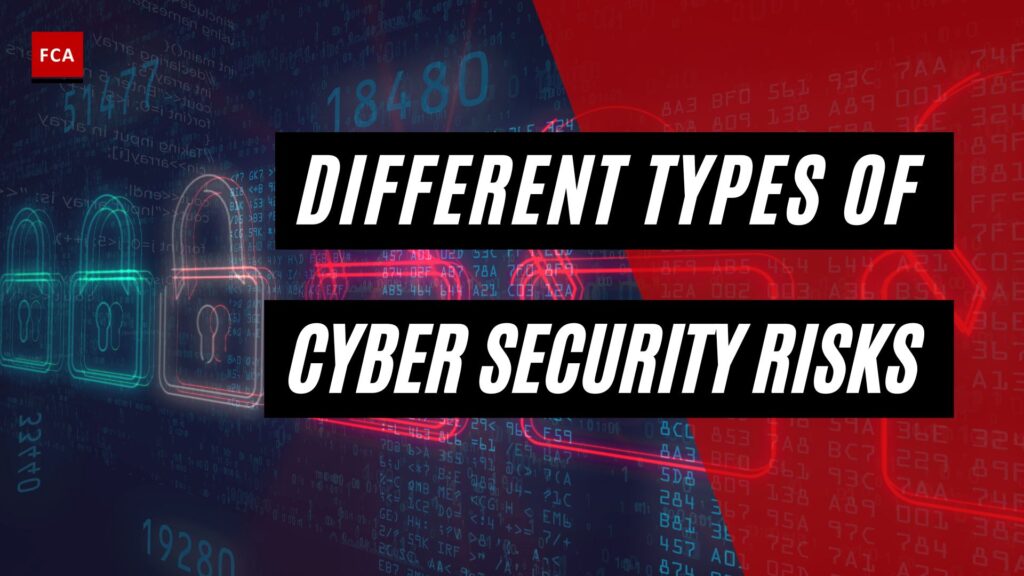There are different types of cyber security risks and threats faced by organizations in which, if they occur, they cause the loss of confidential information, data, or access to the information system. These cybersecurity risks include malware, emotet, phishing, denial of service, SQL injection, a man in the middle, and password attacks.
Different Types of Cyber Security Risks
Organizations face various types of cyber security risks, which, if they occur, cause the loss of information and resources.
Here are some of the significant cybersecurity risk types which cause data and information losses:
- Malware
Malware is malicious software such as spyware, ransomware, viruses, and worms. Malware is activated when a user clicks on a malicious link or attachment, leading to dangerous software installation.
Cisco reports that malware, once activated, can:
- Block access to key network components or ransomware
- Install additional harmful software
- Covertly obtain information by transmitting data from the hard drive or spyware
- Disrupt individual parts, making the system inoperable
- Emotet
The Cyber security and Infrastructure Security Agency or CISA describes Emotet as “an advanced, modular banking Trojan that primarily functions as a downloader or dropper of other banking Trojans. Emotet continues to be among the most costly and destructive malware.”


- Denial of Service
A denial of service or DoS is a cyber-attack that floods a computer or network so it can’t respond to requests. A distributed DoS or DDoS does the same thing, but the attack originates from a computer network. Cyber attackers use a flood attack to disrupt the handshake process, and they carry out a DoS. Other techniques may also be used. Some cyber-attackers use the time a network is disabled to launch other attacks.
A botnet is a type of DDoS in which millions of systems can be infected with malware and controlled by a hacker, according to Jeff Melnick of Netwrix, an information technology security software company. Botnets, sometimes called zombie systems, target and overwhelm a target’s processing capabilities. Botnets are in different geographic locations and are hard to trace.
- Phishing
Phishing attack uses a fake email or communication to trick the recipient into opening the email or communication message and carrying out the instructions provided in such email or communication, such as providing a credit card number. The goal is to steal sensitive data, like credit card and login information, or install malware on the victim’s machine to gain access to confidential information.
- Man in the Middle
A man-in-the-middle attack occurs when the hackers insert themselves into a two-party transaction. After interrupting the traffic, they can filter and steal the information or data. This attack often occurs when a visitor uses an unsecured public Wi-Fi network. The attacker inserts himself between the visitor and the network, then uses the malware to install software and use the data maliciously.
- SQL Injection
A Structured Query Language or SQL injection is a cyber-attack resulting from inserting malicious code into the SQL server. When infected through the SQL code, the server releases information. Submitting the malicious code can be as simple as entering it into a vulnerable website search box.
- Password Attacks
A cyber attacker may gain access to a system and information with the right password. Social engineering is a type of password attack strategy that cyber attackers use that relies heavily on human interaction and often involves tricking people into breaking standard security practices. The other types of password attacks include accessing a password database of the organization or performing outright guessing.


Final Thoughts
The probability of exposure or loss as a result of a cyber attack or data breach on your organization is referred to as cybersecurity risk. A better, more comprehensive definition is the potential loss or harm caused by an organization’s technical infrastructure, use of technology, or reputation. Because of the increasing reliance on computers, networks, programs, social media, and data worldwide, organizations are becoming more vulnerable to cyber threats.
Data breaches, a common cyber attack, have a massive negative business impact and are frequently the result of inadequately protected data. The cybersecurity risks include malware, emotet, phishing, denial of service, SQL injection, a man in the middle, and password attacks.







